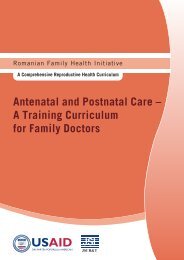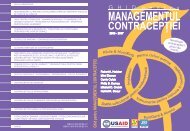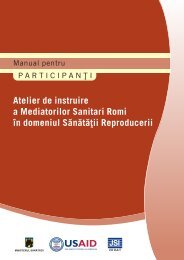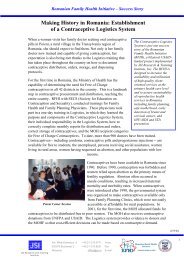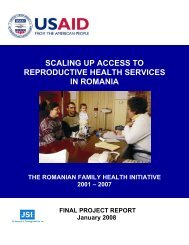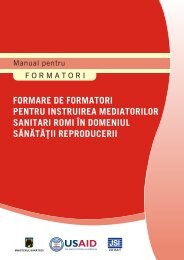Training of Roma Health Mediators in Reproductive Health
Training of Roma Health Mediators in Reproductive Health
Training of Roma Health Mediators in Reproductive Health
Create successful ePaper yourself
Turn your PDF publications into a flip-book with our unique Google optimized e-Paper software.
• The importance, and the benefits, <strong>of</strong> breastfeed<strong>in</strong>g<br />
• Pr<strong>in</strong>ciples <strong>of</strong> breastfeed<strong>in</strong>g<br />
• Essential techniques and positions for successful breastfeed<strong>in</strong>g<br />
• Common problems that may arise and what to do <strong>in</strong> case they occur<br />
• Common myths about breastfeed<strong>in</strong>g and how to best respond to them<br />
Production <strong>of</strong> breast milk<br />
Expla<strong>in</strong> that:<br />
• Inside the breast are millions <strong>of</strong> very small sacs which produce milk under the<br />
control <strong>of</strong> a hormone produced <strong>in</strong> the bra<strong>in</strong>. Muscles surround<strong>in</strong>g these sacs<br />
contract and squeeze the milk out through small tubes which carry milk from the<br />
sacs to the outside, through the nipple. The sacs and tubes are surrounded by fat<br />
and other tissue which give the breast its shape, and which make most <strong>of</strong> the<br />
difference between large and small breasts. Small breasts and large breasts both<br />
conta<strong>in</strong> about the same amount <strong>of</strong> small sacs and tubes and can both make plenty<br />
<strong>of</strong> milk.<br />
• When the baby suckles at the breast, impulses go from the nipple to the mother’s<br />
bra<strong>in</strong> which stimulates the small sacs to produce milk. If the baby suckles more,<br />
the mother will produce more milk for the next feed. If the baby suckles less, the<br />
mother will produce less milk for the next feed. The amount <strong>of</strong> milk produced is<br />
adjusted by the mother’s body to meet the needs <strong>of</strong> her baby.<br />
• The hormone that causes the muscles around the sacs to contract and milk to flow<br />
through the tubes also causes a mother’s uterus to contract after delivery. This<br />
helps to reduce bleed<strong>in</strong>g, but it sometimes causes uter<strong>in</strong>e pa<strong>in</strong> and a rush <strong>of</strong> blood<br />
dur<strong>in</strong>g a feed for the first few days. The pa<strong>in</strong>s can be quite strong. It is important<br />
to tell the mother about this so that she does not worry. It is good for the heal<strong>in</strong>g<br />
<strong>of</strong> her body after delivery and will stop <strong>in</strong> a few days.<br />
• The production <strong>of</strong> milk <strong>in</strong> the mother’s breast is affected by her thoughts,<br />
feel<strong>in</strong>gs and sensations. Positive thoughts and feel<strong>in</strong>gs (such as love,<br />
confidence, happ<strong>in</strong>ess and pride) and sensations (such as touch<strong>in</strong>g and hear<strong>in</strong>g<br />
or see<strong>in</strong>g her baby) can help the milk to flow. Bad feel<strong>in</strong>gs (such as pa<strong>in</strong>,<br />
worry, fear or doubt) can stop her milk from flow<strong>in</strong>g. Fortunately, this effect is<br />
usually temporary.<br />
• Signs <strong>of</strong> good milk production may <strong>in</strong>clude: t<strong>in</strong>gl<strong>in</strong>g sensation <strong>in</strong> the breasts just<br />
before or dur<strong>in</strong>g a feed; milk flow<strong>in</strong>g or dripp<strong>in</strong>g from the breasts; pa<strong>in</strong>ful<br />
uter<strong>in</strong>e contractions, sometimes with a rush <strong>of</strong> blood, dur<strong>in</strong>g feeds <strong>in</strong> the first<br />
week; and slow deep sucks and swallow<strong>in</strong>g by the baby as he feeds.<br />
Importance and benefits <strong>of</strong> breastfeed<strong>in</strong>g:<br />
Expla<strong>in</strong> that:<br />
• Babies who are breastfed are healthier, grow stronger, and are less likely to die<br />
140<br />
RFHI/JSI <strong>Roma</strong>nia <strong>Tra<strong>in</strong><strong>in</strong>g</strong> <strong>of</strong> RHMs <strong>in</strong> <strong>Reproductive</strong> <strong>Health</strong> Session 9: Breastfeed<strong>in</strong>g



